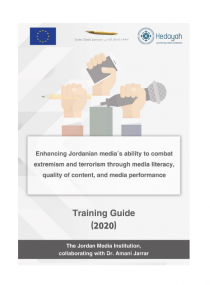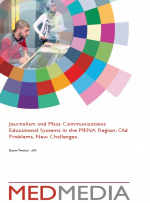Image:

11 Jan 2016
<div style="text-align: justify;"><strong>11 January 2016</strong><br />
<br />
Jordan Media Institute (JMI) has recently published a book entitled, “Transformations towards Modernity in News Writing … Research and Application” by Dr. Jad Jubran Karam, professor of news writing and editing at the Institute. The book is the second in a series on media information.<br />
<br />
The book, a pioneering Arab effort in the field, tackles modern approaches to news writing and editing. With his vast experience and knowledge of editing styles worldwide, the researcher aspires to develop writing styles in Arab journalism.<br />
<br />
In the foreword, Princess Rym Ali, founder of JMI, said the book lays the foundations for a new approach in dealing with news, and writing in Arabic, taking into consideration the changes created by technology in modern journalism and media.<br />
<br />
JMI Dean, Dr. Basim Tweissi, explained the value of the book in responding to the challenges incorporated in the shift from traditional journalism to modern approaches in news writing and editing.<br />
<br />
The book consists of 300 pages of medium size and includes two sections: “Transformations in Journalism and News Items” and “News Editing Facets in Application”<br />
<br />
The first section has three chapters: “Constants Lay Siege to Developments”, “Contributions of Non-Print News in Modernization” and “News in Current Vision”.<br />
<br />
This section compares traditional editing techniques with new news-making standards and modern writing styles in addition to people’s position on those standards.<br />
<br />
The author analyzes the contribution of non-print news, how writing and editing styles are updated to cope with new technologies and how to deal with multiple sources provided by technological development.<br />
<br />
The second section of the book includes three chapters: “Between Newsrooms and the Field”, “Types of Coverage in Serious Field Reports” and “Beyond Coverage Point”.<br />
<br />
This section contains examples of news editing from newspapers and detailed coverage of demonstrations, elections and disasters.<br />
<br />
The book as a whole represents a roadmap for new media and an attempt to revolt against slow traditional media through inventing new ways to access information that is available on various channels including smart phones and social media, while responsibly processing it and ensuring the sources are verified and media and journalism ethics and the various codes of ethics are respected.<br />
<br />
It focuses on creating a multi-skilled modern journalist who can utilize modern technologies and replace the traditional pen and paper with a smart phone and a multi-purpose digital camera; a Journalist who can be a reporter, editor and critic, and can produce news for radio, television, website and print media.<br />
<br />
The book is part of a series of publications released by JMI last year on media information, culture and translated works. </div>



